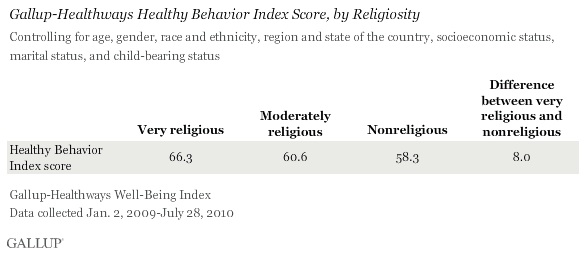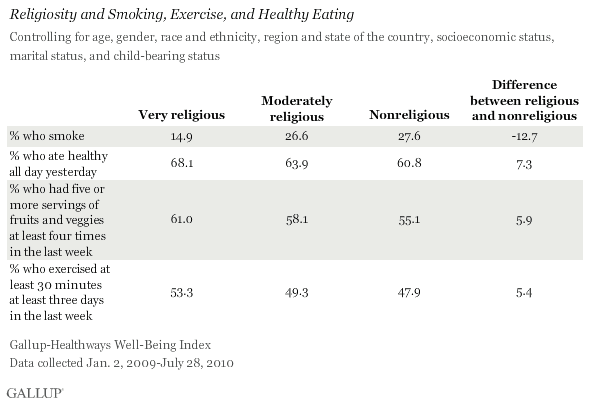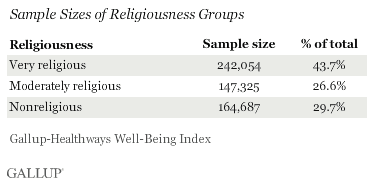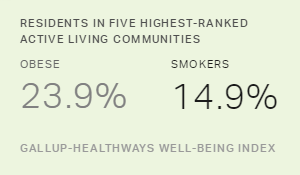This is the third article in a special multipart series on religiosity and well-being in America. The explored the relationship between religiosity and well-being across the Well-Being Index and sub-indexes. The examined religiosity and emotional health. This piece explores specific components within the Healthy Behavior Index.
PRINCETON, NJ -- Very religious Americans are more likely to practice healthy behaviors than those who are moderately religious or nonreligious. The most religious Americans score a 66.3 on the Gallup-Healthways Healthy Behavior Index compared with 60.6 among those who are moderately religious and 58.3 for the nonreligious. This relationship, based on an analysis of more than 550,000 interviews, is statistically significant after controlling for major demographic and regional variables.

For the purposes of this analysis, an American's relative degree of religiousness is based on responses to two questions asking about the importance of religion and church attendance, yielding three specific groups:
- Very religious -- Religion is an important part of daily life and church/synagogue/mosque attendance occurs at least every week or almost every week. This group constitutes 43.7% of the adult population.
- Moderately religious -- All others who do not fall into the very religious or nonreligious groups but who gave valid responses on both religion questions. This group constitutes 26.6% of the adult population.
- Nonreligious -- Religion is not an important part of daily life and church/synagogue/mosque attendance occurs seldom or never. This group constitutes 29.7% of the adult population.
Previous research has shown that religiosity, defined either as church attendance or self-reported importance of religion, is related to age, gender, race and ethnicity, region and state of the country, socioeconomic status, marital status, and child-bearing status. Because well-being is also related to these variables, this analysis statistically controls for all of these characteristics.
Very Religious Smoke Less, Exercise More, and Eat Healthier
Very religious Americans make healthier choices than their moderately religious and nonreligious counterparts across all four of the Healthy Behavior Index metrics, including smoking, healthy eating, and regular exercise. Smoking is one area of particular differentiation between the very religious and less religious Americans, with the nonreligious 85% more likely to be smokers than those who are very religious.

Very religious Americans also outperform the moderately religious and nonreligious in terms of eating healthy and getting frequent exercise.
Implications
There are a number of factors that could contribute to very religious Americans' healthier lifestyle choices. Some of these factors are likely overt products of religious doctrine itself, including rules related to smoking and substance abuse. Seventh-Day Adventists, for example, strictly adhere to vegetarian lifestyles free of alcohol and smoking, while orthodox Mormons and Muslims do not drink alcohol. In some Christian denominations, gluttony and sloth are considered two of the seven deadly sins, and many evangelical faiths frown on drinking and smoking. The Bible indicates that one's body is the "temple of God," which could in turn help explain the relationship between religious orthodoxy and exercise and certain types of food consumption.
It is possible, of course, that the noted relationship between health and religiosity could go in the other direction -- that people who are healthier are the most likely to make the decision to be religious. This could be particularly relevant in terms of church attendance, one of the constituent components of Gallup's definition of religiousness. Healthier people may be more likely and able to attend religious services than those who are less healthy.
It may also be possible that certain types of individuals are more likely to make healthy lifestyle choices and more likely to choose to be highly religious. The most parsimonious explanation, however, may be the most intuitive: Those who capitalize on the social and moral outcomes of religious norms and acts are more likely to lead lives filled with healthier choices.
优蜜传媒will continue to explore the relationship between well-being and religion in future articles.
About the Gallup-Healthways Well-Being Index
The Gallup-Healthways Well-Being Index tracks U.S. well-being and provides best-in-class solutions for a healthier world. To learn more, please visit .
Survey Methods
Results are based on telephone interviews conducted as part of the Gallup-Healthways Well-Being Index survey Jan. 2-July 28, 2010, with a random sample of 554,066 adults, aged 18 and older, living in all 50 U.S. states and the District of Columbia, selected using random-digit-dial sampling. Of this sample, very religious respondents comprised the plurality (43.2%), with slightly more than one-quarter each for moderately religious and nonreligious respondents.

For results based on the religiosity groups of national adults, one can say with 95% confidence that the maximum margin of sampling error is 卤0.5 percentage point for each group.
Generalized linear model analysis was used to estimate marginal scores all five reported metrics after controlling for age (in years), gender, race/ethnicity, marital status, education (number of years), log of income, and region of the country.
Interviews are conducted with respondents on landline telephones and cellular phones, with interviews conducted in Spanish for respondents who are primarily Spanish-speaking. Each daily sample includes a minimum quota of 150 cell phone respondents and 850 landline respondents, with additional minimum quotas among landline respondents for gender within region. Landline respondents are chosen at random within each household on the basis of which member had the most recent birthday.
Samples are weighted by gender, age, race, Hispanic ethnicity, education, region, adults in the household, cell phone-only status, cell phone-mostly status, and phone lines. Demographic weighting targets are based on the March 2009 Current Population Survey figures for the aged 18 and older non-institutionalized population living in U.S. telephone households. All reported margins of sampling error include the computed design effects for weighting and sample design.
In addition to sampling error, question wording and practical difficulties in conducting surveys can introduce error or bias into the findings of public opinion polls.
For more details on Gallup's polling methodology, visit .
